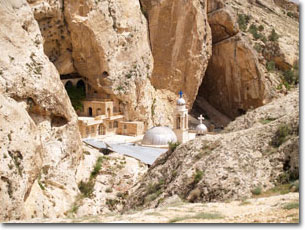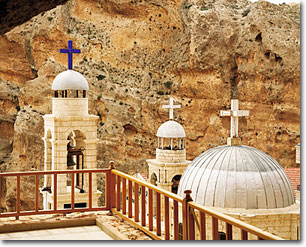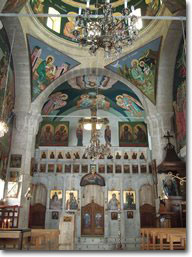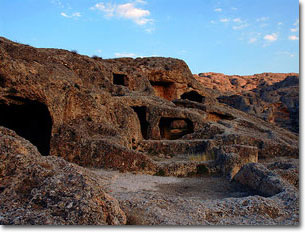|
50 km north of Damascus; Maalula is situated at an altitude of more than 1500 meters. By far, the most important Christian site in Syria is the magnificent village of Maalula. The word Maalula means entrance in Aramaic, probably referring to the gorge in between the mountains. Maalula is the one of the few remaining villages in the world that still speak Aramaic, the language of Jesus Christ.
Though rich in historical and religious associations, Maalula preserves only a few remains of its past. It is, however, a village of some charm, its tempered houses piled up on the lower slopes of an escarpment rising sheer above the village. There is an uncompromising beauty to the setting and the gorge that cuts into the escarpment at the back.
Maalula has three claims to fame; its setting; its early Christian associations; and the resistance of the villagers to the final replacement of Aramaic by Arabic as the language of communication. There may be some doubt about the extent to which Aramaic, the language spoken by Christ and the popular lingua franca of the area until the Arab conquest in the seventh century, has remained in active use to the present day. However, even the vestigial survival of West Aramaic (Syriac) as a spoken tongue indicates the tenacity with which the inhabitants of Maalula have clung to their identity.
St Sergius Chapel
There are two chapels above the village whose loyalty is divided between the Greek Catholic and the Orthodox churches. The first chapel, which is of the Greek Catholics, is on the escarpment left of the gorge; the St. Sergius convent (Mar Sarkis). This tiny chapel,  probably built on the site of a pagan temple, has architectural elements which go back to Byzantine period and may have been constructed even before the Council of Nicaea in 325; that is evidenced by the fact that it has a round altar, which was prohibited at the Council. Mar Sarkis is designed after the pattern of the martyrion (a shrine dedicated to a martyr) and is dedicated to Mar Sarkis (St. Sergius), a Roman soldier who was executed for his Christian beliefs (Sergius has a grander basilica in Resafe, Syria). It has a beautiful display of icons on the entrance to the altar; they date back to the 13th to 18th centuries, including one of the Virgin Mary and another of the martyrs Sergius and Bacchus. This chapel is considered one of the oldest, if not the oldest, in Christendom. On the plateau behind the church, there are also remains of ancient rock-cut tombs. probably built on the site of a pagan temple, has architectural elements which go back to Byzantine period and may have been constructed even before the Council of Nicaea in 325; that is evidenced by the fact that it has a round altar, which was prohibited at the Council. Mar Sarkis is designed after the pattern of the martyrion (a shrine dedicated to a martyr) and is dedicated to Mar Sarkis (St. Sergius), a Roman soldier who was executed for his Christian beliefs (Sergius has a grander basilica in Resafe, Syria). It has a beautiful display of icons on the entrance to the altar; they date back to the 13th to 18th centuries, including one of the Virgin Mary and another of the martyrs Sergius and Bacchus. This chapel is considered one of the oldest, if not the oldest, in Christendom. On the plateau behind the church, there are also remains of ancient rock-cut tombs.
St Thecla Monastery
Downward into the village, on the right of the gorge, is the other chapel, a Greek Orthodox institution dedicated to St Thecla (Mar Takla), it's located in the lower monastery. Thecla was the daughter of a Seleucid prince and a young disciple of St. Paul whose dramatic life story is told in the apocryphal, and possibly legendary, Acts of Paul and Thecla. She is believed to be buried in the mountain just above the monastery. On the road that leaves the village; look for a steep path on the right that leads to a terrace where a small waterfall welcomes the pilgrims. The building was constructed on several levels. On the top floor is a modern church with a dome and a cave into which filters water with miraculous properties. This religious monument receives an unending stream of Christian and Muslim pilgrims. Other religious relics can be found in the convent but what strikes one most is the peaceful atmosphere of the place. St. Paul whose dramatic life story is told in the apocryphal, and possibly legendary, Acts of Paul and Thecla. She is believed to be buried in the mountain just above the monastery. On the road that leaves the village; look for a steep path on the right that leads to a terrace where a small waterfall welcomes the pilgrims. The building was constructed on several levels. On the top floor is a modern church with a dome and a cave into which filters water with miraculous properties. This religious monument receives an unending stream of Christian and Muslim pilgrims. Other religious relics can be found in the convent but what strikes one most is the peaceful atmosphere of the place.
There are two parish churches in the village itself. In one (of St. Elias), a fourth century mosaic was found.
Maalula have a collection of unique religious and festive songs and a great sense of community and festivity. There are three major festivals: the Holy Cross Festival on September 14; the  Festival of Mar Takla on September 22; and the festival of Mar Sarkis on October 7. Hundreds of visitors attend these celebrations and they enjoy some of the most imaginative festivals in the whole of Syria. Festival of Mar Takla on September 22; and the festival of Mar Sarkis on October 7. Hundreds of visitors attend these celebrations and they enjoy some of the most imaginative festivals in the whole of Syria. |


